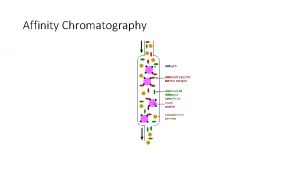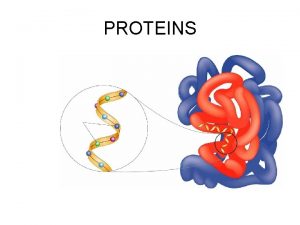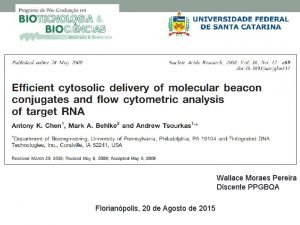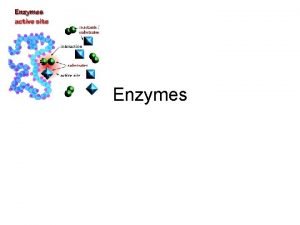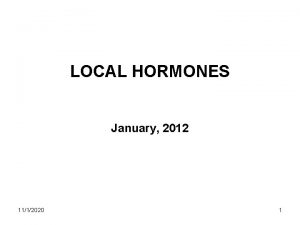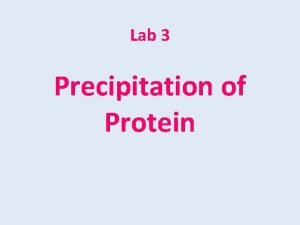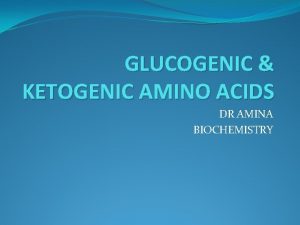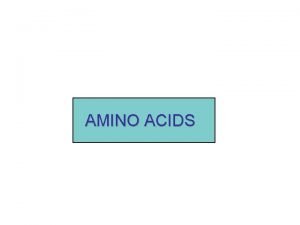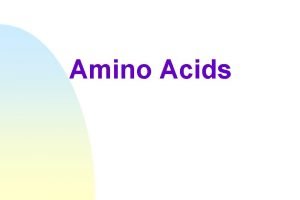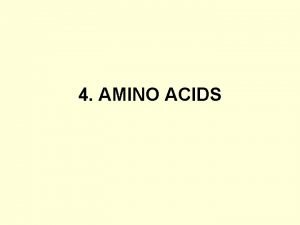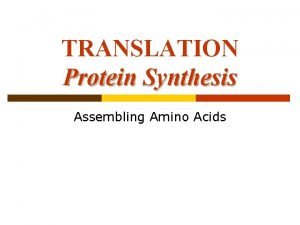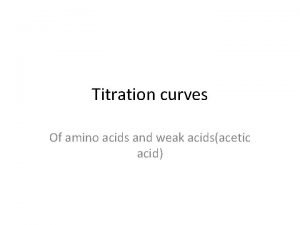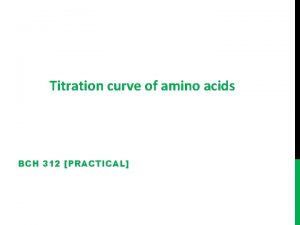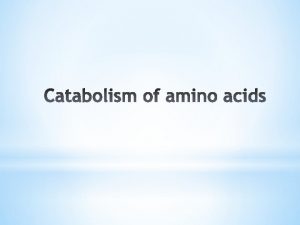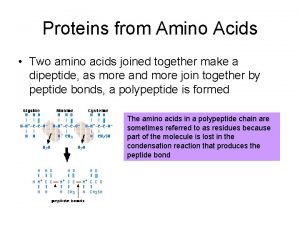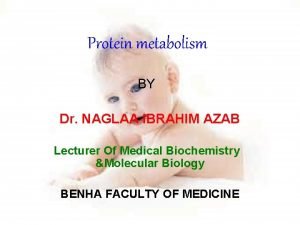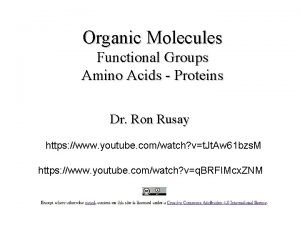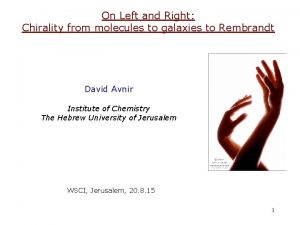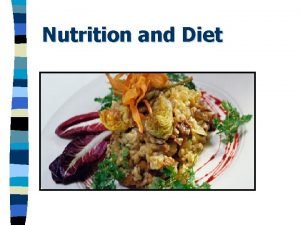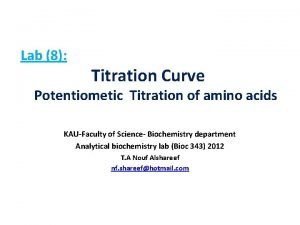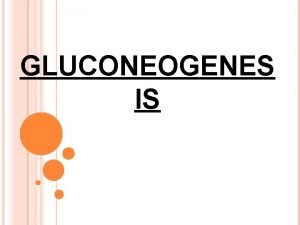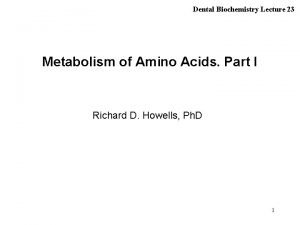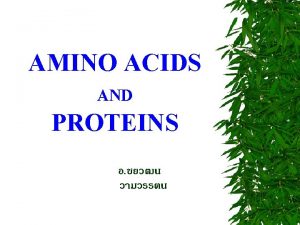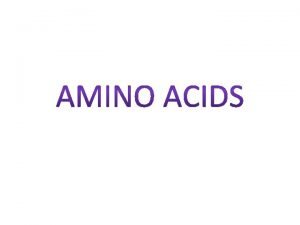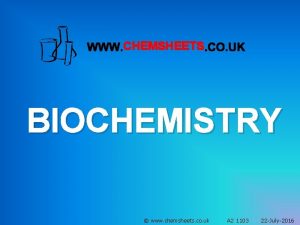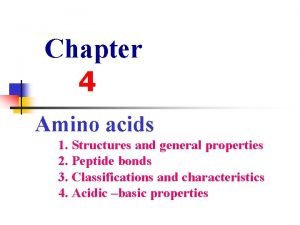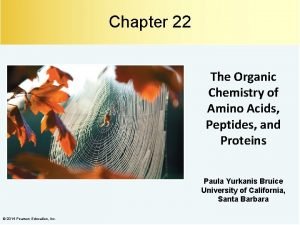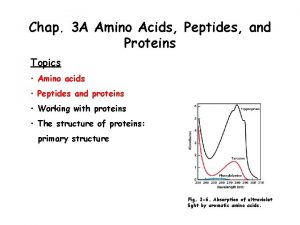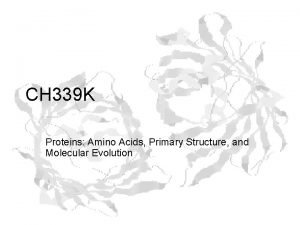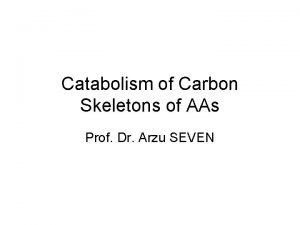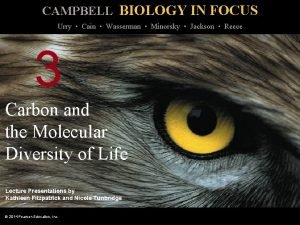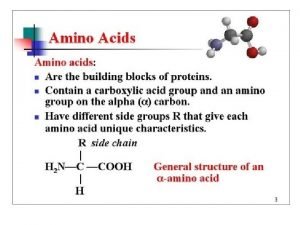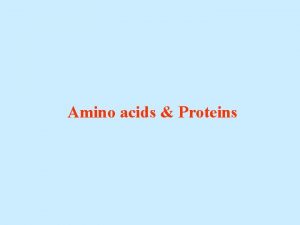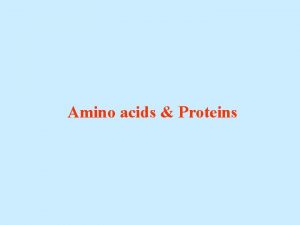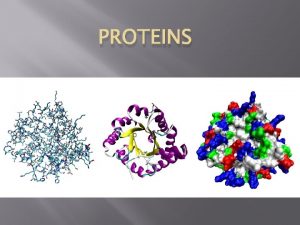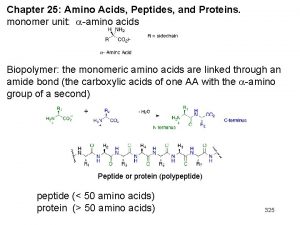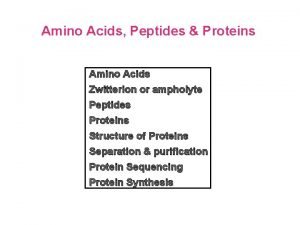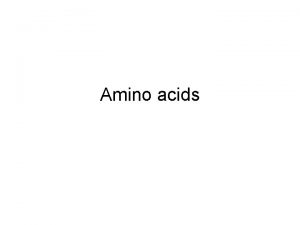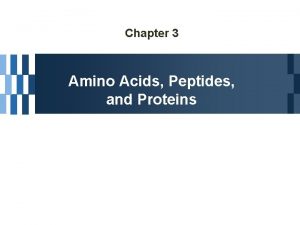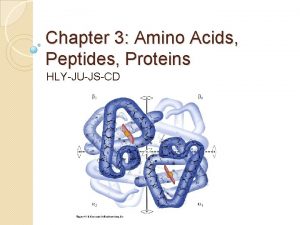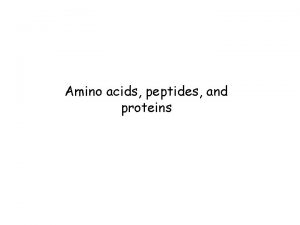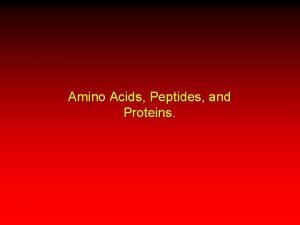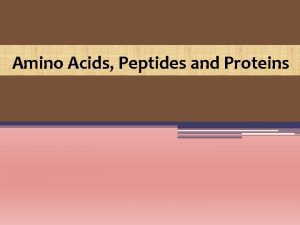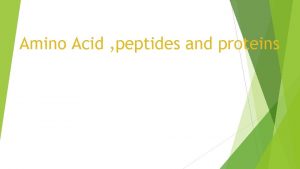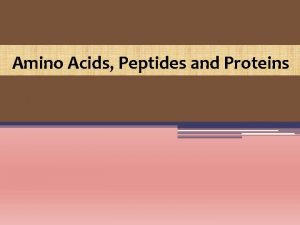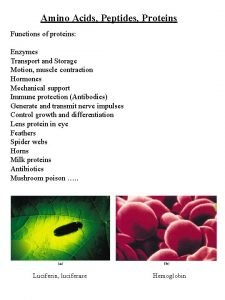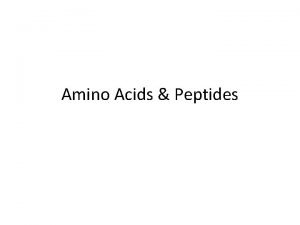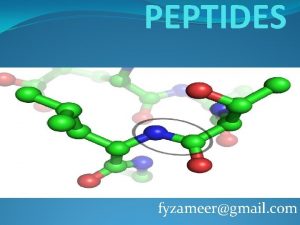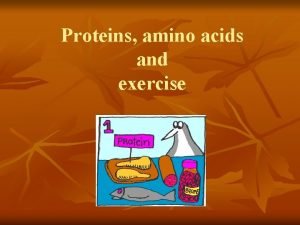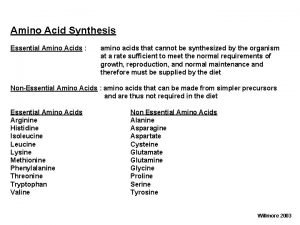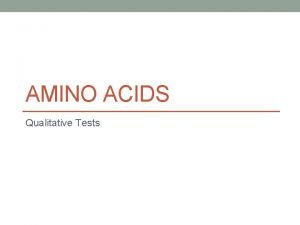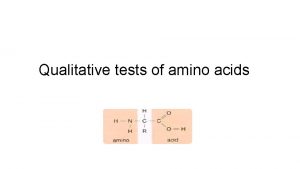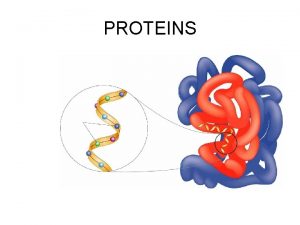Chapter 27 Amino Acids Peptides and Proteins monomer

































- Slides: 33

Chapter 27: Amino Acids, Peptides, and Proteins. monomer unit: -amino acids Biopolymer: the monomeric amino acids are linked through an amide bond (the carboxylic acids of one AA with the -amino group of a second) Peptide or protein (polypeptide) peptide (< 50 amino acids) protein (> 50 amino acids) 307

27. 1: Classification of Amino Acids. AA’s are classified according to the location of the amino group. There are 20 genetically encoded -amino acids found in peptides and proteins 19 are primary amines, 1 (proline) is a secondary amine 19 are “chiral”, 1 (glycine) is achiral; the natural configuration of the -carbon is L. 308

-Amino acids are classified by the properties of their sidechains. Nonpolar: Polar but non-ionizable: 309

Acidic: Basic: 27. 2: Stereochemistry of Amino Acids: The natural configuration of the -carbon is L. D-Amino acids are found in the cell walls of bacteria. The D-amino acids are not genetically encoded, but derived from the epimerization of L-isomers 310

27. 3: Acid-Base Behavior of Amino Acids. Amino acids exist as a zwitterion: a dipolar ion having both a formal positive and formal negative charge (overall charge neutral). p. Ka ~ 5 p. Ka ~ 9 Amino acids are amphoteric: they can react as either an acid or a base. Ammonium ion acts as an acid, the carboxylate as a base. Isoelectric point (p. I): The p. H at which the amino acid exists largely in a neutral, zwitterionic form (influenced by the nature of the sidechain) Table 27. 2 (p. 1115) & 27. 2 (p. 1116) 311

p. Kax + p. Kay p. I = 2 312

Electrophoresis: separation of polar compounds based on their mobility through a solid support. The separation is based on charge (p. I) or molecular mass. 313

27. 5: Synthesis of Amino Acids: Ch. 19. 16 Strecker Synthesis: recall reductive amination Amidomalonate Synthesis: recall the malonic acid synthesis 314

27. 5: Reactions of Amino Acids. Amino acids will undergo reactions characteristic of the amino (amide formation) and carboxylic acid (ester formation) groups. 27. 6: Some Biochemical Reactions of Amino Acids. Many enzymes involved in amino acid biosynthesis, metabolism and catabolism are pyridoxal phosphate (vitamin B 6) dependent (please read) 315

27. 7: Peptides. Proteins and peptides are polymers made up of amino acid units (residues) that are linked together through the formation of amide bonds (peptide bonds) from the amino group of one residue and the carboxylate of a second residue By convention, peptide sequences are written left to right from the N-terminus to the C-terminus backbone 316

The amide (peptide) bond has C=N double bond character due to resonance resulting in a planar geometry restricts rotations resistant to hydrolysis The N-H bond of one amide linkage can form a hydrogen bond with the C=O of another. N-O distance 2. 85 - 3. 20 Å optimal N-H-O angle is 180 ° Disulfide bonds: the thiol groups of cysteine can be oxidized to form disulfides (Cys-S-S-Cys) 317

Epidermal Growth Factor (EGF): the miracle of mother’s spit 53 amino acid, 3 disulfide linkages 1986 Nobel Prize in Medicine: Stanley Cohen Rita Levi-Montalcini 318

27. 8: Introduction to Peptide Structure Determination. Protein Structure: primary (1°) structure: the amino acid sequence secondary (2°): frequently occurring substructures or folds tertiary (3°): three-dimensional arrangement of all atoms in a single polypeptide chain quaternary (4°): overall organization of non-covalently linked subunits of a functional protein. 1. Determine the amino acids present and their relative ratios 2. Cleave the peptide or protein into smaller peptide fragments and determine their sequences 3. Cleave the peptide or protein by another method and determine their sequences. Align the sequences of the peptide fragments from the two methods 319

E-A-Y-L-V-C-G-E-R F-V-N-Q-H-L-F-S-H-L-K G-C-F-L-P-K L-G-A F-V-N-Q-H-L-F S-H-L-K-E-A-Y L-V-C-G-E-R-G-C-F L-P-K-L-G-A F-V-N-Q-H-L-F-S-H-L-K-E-A-Y-L-V-C-G-E-R-G-C-F-L-P-K-L-G-A F-V-N-Q-H-L-F-S-H-L-K-E-A-Y-L-V-C-G-E-R-G-C-F-L-P-K-L-G-A 320

27. 9: Amino Acid Analysis. automated method to determine the amino acid content of a peptide or protein Reaction of primary amines with ninhydrin peptide -orprotein [H] reduce any disulfide bonds liquid chromatography Enzymatic digestion -or. H 3 O+, derivatize w/ ninhydrin Different amino acids have different chromatographic mobilities (retention times) individual amino acids Detected w/ UV-vis 1972 Nobel Prize in Chemistry William Stein Stanford Moore 321

27. 10: Partial Hydrolysis of Peptides. Acidic hydrolysis of peptides cleave the amide bonds indiscriminately. Proteases (peptidases): Enzymes that catalyzed the hydrolysis of the amide bonds of peptides and proteins. Enzymatic cleavage of peptides and proteins at defined sites: • trypsin: cleaves at the C-terminal side of basic residues, Arg, Lys but not His • chymotrypsin: cleaves at the C-terminal side of aromatic residues Phe, Tyr, Trp 322

Trypsin and chymotrypsin are endopeptidases Carboxypeptidase: Cleaves the amide bond of the C-terminal amino acid (exopeptidase) 27. 11: End Group Analysis. The C-terminal AA is identified by treating with peptide with carboxypeptidase, then analyzing by liquid chormatography (AA Analysis). N-labeling: The peptide is first treated with 1 -fluoro-2, 4 -dinitro benzene (Sanger’s reagent), which selectively reacts with the N-terminal amino group. The peptide is then hydrolyzed to their amino acids and the N-terminal amino acid identified as its N-(2, 4 -dinitrophenyl) derivative (DNP). 323

27. 12: Insulin. (please read) Insulin has two peptide chains (the A chain has 21 amino acids and the B chain has 30 amino acids) held together by two disulfide linkages Pepsin: cleaves at the C-terminal side of Phe, Tyr, Leu; but not at Val or Ala Pepsin cleavage Trypsin cleavage H 3 O+ cleavage 324

27. 13: The Edman Degradation and Automated Peptide Sequencing. Chemical method for the sequential cleavage and identification of the amino acids of a peptide, one at a time starting from the N-terminus. Reagent: Ph-N=C=S, phenylisothiocyanate (PITC) -1 peptide with a new N-terminal amino acid (repeat degradation cycle) N-phenylthiohydantoin: separated by liquid chromatography (based of the R group) and detected by UV-vis 325

Peptide sequencing by Edman degradation: • Cycle the p. H to control the cleavage of the N-terminal amino acid by PITC. • Monitor the appearance of the new N-phenylthiohydantoin for each cycle. • Good for peptides up to ~ 25 amino acids long. • Longer peptides and proteins must be cut into smaller fragments before Edman sequencing. Tandem mass spectrometry has largely replaced Edman degradation for peptide sequencing 27. 14: The Strategy for Peptide Synthesis: Chemical synthesis of peptide: 1. Solution phase synthesis 2. Solid-phase synthesis 326

The need for protecting groups Orthogonal protecting group strategy: the carboxylate protecting group must be stable to the reaction conditions for the removal of the -amino protecting group and ( vice versa) 327

27. 15: Amino Group Protection. The -amino group is protected as a carbamate. 27. 16: Carboxyl Group Protection. Protected as a benzyl ester; removed by hydrogenolysis 328

27. 17: Peptide Bond Formation. Amide formation from the reaction of an amine with a carboxylic acid is slow. Amide bond formation (peptide coupling) can be accelerated if the carboxylic acid is activated. Reagent: dicyclohexylcarbodiimide (DCC) 329

• In order to practically synthesize peptides and proteins, time consuming purifications steps must be avoided until the very end of the synthesis. • Large excesses of reagents are used to drive reactions forward and accelerate the rate of reactions. • How are the excess reagents and by-products from the reaction, which will interfere with subsequent coupling steps, removed without a purification step? 27. 18: Solid-Phase Peptide Synthesis: The Merrifield Method. Peptides and proteins up to ~ 100 residues long are synthesized on a solid, insoluble, polymer support. Purification is conveniently accomplished after each step by a simple wash and filtration. 330

The solid support (Merrifield resin): polystyrene polymer Solid-phase peptide synthesis 331

Ribonuclease A- 124 amino acids, catalyzes the hydrolysis of RNA Solid-phase synthesis of RNase A: Synthetic RNase A: 78 % activity 0. 4 mg was synthesized 2. 9 % overall yield average yield ~ 97% per coupling step His-119 A LYS GLN SER LYS LEU LYS ASN ILE LYS GLN GLU ASP GLU HIS SER PRO ALA ASN CYS THR TYR ALA GLY ALA THR MET SER ARG VAL ASP VAL TYR ASP PRO ASN SER ALA ASP ASN ASN VAL ALA GLN CYS ASN LYS PRO VAL ALA SER TYR LEU THR GLN CYS SER ARG CYS HIS TYR ALA SER CYS THR PHE ALA LYS TYR GLU ALA ILE VAL LYS THR ASN LYS VAL ASN SER THR TYR ILE PRO PHE SER GLN ASP HIS CYS GLY THR GLY LYS VAL GLU ALA MET ARG GLU SER GLN MET SER THR ALA HIS ARG ALA MET CYS SER GLN THR SER THR CYS PHE His-12 A His-12 B His-119 B pdb code: 1 AFL R. Bruce Merrifield, Rockefeller University, 1984 Nobel Prize in Chemistry: “for his development of methodology for chemical synthesis on a solid matrix. ” 332

27. 19: Secondary Structures of Peptides and Proteins. -sheet: Two or more extended peptide chain, in which the amide backbones are associated by hydrogen bonded anti-parallel N C loop or turn N C C N parallel N C crossover N C 333

-helix: 3. 6 amino acids per coil, 5. 4 Å C 3. 6 AA 5. 4 Å N 334

myoglobin pdb code: 1 WLA Bacteriorhodopsin pdb code: 1 AP 9 Parallel -sheets carbonic anhydrase pdb code: 1 QRM Anti-parallel -sheets of lectin pdb code: 2 LAL 335

27. 20: Tertiary Structure of polypeptides and Proteins. Fibrous. Polypeptides strands that “bundle” to form elongated fibrous assemblies; insoluble; Globular. Proteins that fold into a “spherical” conformation. Hydrophobic effect. Proteins will fold so that hydrophobic amino acids are on the inside (shielded from water) and hydrophilic amino acids are on the outside (exposed to water). Pro • Ile • Lys • Tyr • Leu • Glu • Phe • Ile • Ser • Asp • Ala • Ile • His • Val • His • Ser • Lys 336

Enzymes: proteins that catalyze biochemical reactions. • by bringing the reactive atoms together in the optimal geometry for the reaction. • lowering the activation energy ( G‡) by stabilizing the transition state and/or high energy intermediate. • many enzymes use the functional groups of the amino acid sidechain to carry out the reactions Proteases (peptidases): catalyzes the hydrolysis of peptide bonds Four classes of proteases: Serine (trypsin): aspartate-histidine-serine Aspartyl (HIV protease, renin): two aspartates Cysteine (papain, caspase): histidine-cysteine Metallo (Zn 2+) (carboxypeptidase, ACE): glutamate 337

Mechanism of carboxylpeptidase, metalloprotease (p. 1151) Mechanism of a serine protease (trypsin, chymotrypsin): 338

27. 21: Coenzymes. Some reactions require additional organic molecules or metal ions. These are referred to as cofactors or coenzymes. 27. 22: Protein Quaternary Structure. (please read) 339
 Peptides and proteins
Peptides and proteins Peptides and proteins
Peptides and proteins Amino acids are joined together in proteins by
Amino acids are joined together in proteins by Monomer of proteins
Monomer of proteins Cell penetrating peptides
Cell penetrating peptides Image
Image Local hormone
Local hormone Precipitation of proteins by strong mineral acids
Precipitation of proteins by strong mineral acids Glucogenic amino acid
Glucogenic amino acid Is glycine polar or nonpolar
Is glycine polar or nonpolar Ketogenic amino acid
Ketogenic amino acid Difference between hydrophobic and hydrophilic amino acids
Difference between hydrophobic and hydrophilic amino acids Amino acid wheel chart
Amino acid wheel chart Titration curve of arginine
Titration curve of arginine Titration curve of amino acids
Titration curve of amino acids Deamination of amino acids
Deamination of amino acids Amino acids
Amino acids Deamination of glutamine
Deamination of glutamine 20 amino acid structure
20 amino acid structure Right handed amino acids
Right handed amino acids N
N Titration curve of amino acids
Titration curve of amino acids Biomedical importance of glycolysis
Biomedical importance of glycolysis Plp mechanism transamination
Plp mechanism transamination Amino acids groups
Amino acids groups Basic amino acids
Basic amino acids Chemsheets a2 1102 amino acids 2 answers
Chemsheets a2 1102 amino acids 2 answers Optical properties of amino acids
Optical properties of amino acids Carboxypeptidase a cleaves which amino acids
Carboxypeptidase a cleaves which amino acids Serylglycyltyrosylalanylleucine
Serylglycyltyrosylalanylleucine Which amino acids have ionizable side chains
Which amino acids have ionizable side chains Non essential amino acids mnemonics
Non essential amino acids mnemonics Dehydration synthesis of amino acids
Dehydration synthesis of amino acids Aromatic amino acids
Aromatic amino acids

